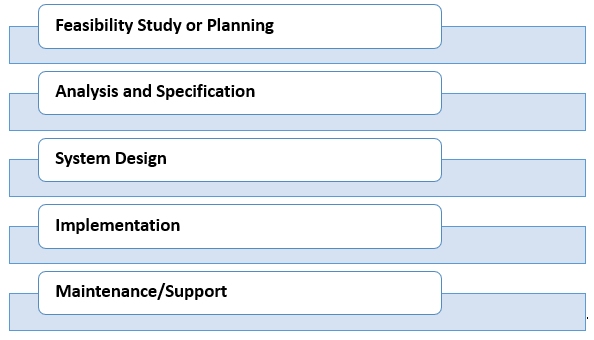System Development Life Cycle
07/08/2021 0 By indiafreenotesAn effective System Development Life Cycle (SDLC) should result in a high quality system that meets customer expectations, reaches completion within time and cost evaluations, and works effectively and efficiently in the current and planned Information Technology infrastructure.
In systems engineering, information systems and software engineering, the software development life cycle (SDLC), also referred to as the application development life-cycle, is a process for planning, creating, testing, and deploying an information system. The systems development life cycle concept applies to a range of hardware and software configurations, as a system can be composed of hardware only, software only, or a combination of both.[2] There are usually six stages in this cycle: requirement analysis, design, development and testing, implementation, documentation, and evaluation.
System Development Life Cycle (SDLC) is a conceptual model which includes policies and procedures for developing or altering systems throughout their life cycles.
SDLC is used by analysts to develop an information system. SDLC includes the following activities:
- Requirements
- Design
- Implementation
- Testing
- Deployment
- Operations
- Maintenance
Phases of SDLC
Systems Development Life Cycle is a systematic approach which explicitly breaks down the work into phases that are required to implement either new or modified Information System.

Feasibility Study or Planning
- Define the problem and scope of existing system.
- Overview the new system and determine its objectives.
- Confirm project feasibility and produce the project Schedule.
- During this phase, threats, constraints, integration and security of system are also considered.
- A feasibility report for the entire project is created at the end of this phase.
Analysis and Specification
- Define the requirements and prototypes for new system.
- Gather, analyze, and validate the information.
- Evaluate the alternatives and prioritize the requirements.
- Examine the information needs of end-user and enhances the system goal.
- A Software Requirement Specification (SRS) document, which specifies the software, hardware, functional, and network requirements of the system is prepared at the end of this phase.
System Design
- Transform the SRS document into logical structure, which contains detailed and complete set of specifications that can be implemented in a programming language.
- Includes the design of application, network, databases, user interfaces, and system interfaces.
- Create a contingency, training, maintenance, and operation plan.
- Review the proposed design. Ensure that the final design must meet the requirements stated in SRS document.
- Finally, prepare a design document which will be used during next phases.
Implementation
- Combine all the modules together into training environment that detects errors and defects.
- Implement the design into source code through coding.
- A test report which contains errors is prepared through test plan that includes test related tasks such as test case generation, testing criteria, and resource allocation for testing.
- Integrate the information system into its environment and install the new system.
Maintenance/Support
- Implement the changes that software might undergo over a period of time, or implement any new requirements after the software is deployed at the customer location.
- Include all the activities such as phone support or physical on-site support for users that is required once the system is installing.
- It also includes handling the residual errors and resolve any issues that may exist in the system even after the testing phase.
- Maintenance and support may be needed for a longer time for large systems and for a short time for smaller systems.
Share this:
- Click to share on Twitter (Opens in new window)
- Click to share on Facebook (Opens in new window)
- Click to share on WhatsApp (Opens in new window)
- Click to share on Telegram (Opens in new window)
- Click to email a link to a friend (Opens in new window)
- Click to share on LinkedIn (Opens in new window)
- Click to share on Reddit (Opens in new window)
- Click to share on Pocket (Opens in new window)
- Click to share on Pinterest (Opens in new window)
- More